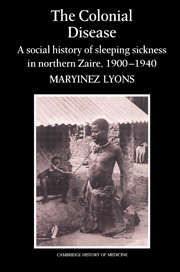Book contents
- Frontmatter
- Contents
- List of maps
- List of plates
- List of tables
- Preface
- List of abbreviations
- Map 1 Africa: political
- 1 Disease and medicine in the history of Africa
- 2 From private empire to public colony
- 3 Mise en valeur: economic exploitation
- 4 Epidemiology and ecology of human sleeping sickness
- 5 ‘The Lure of the Exotic’: sleeping sickness, tropical medicine and imperialism
- 6 Discovery: Liverpool scientists in the Congo
- 7 The campaign. Part one: sleeping sickness and social medicine
- 8 The campaign. Part two: the surveys and tensions
- 9 The African response
- 10 Public health, social engineering and African lives
- 11 Conclusion and legacy
- Appendices
- Notes
- Select bibliography
- Index
4 - Epidemiology and ecology of human sleeping sickness
Published online by Cambridge University Press: 06 January 2010
- Frontmatter
- Contents
- List of maps
- List of plates
- List of tables
- Preface
- List of abbreviations
- Map 1 Africa: political
- 1 Disease and medicine in the history of Africa
- 2 From private empire to public colony
- 3 Mise en valeur: economic exploitation
- 4 Epidemiology and ecology of human sleeping sickness
- 5 ‘The Lure of the Exotic’: sleeping sickness, tropical medicine and imperialism
- 6 Discovery: Liverpool scientists in the Congo
- 7 The campaign. Part one: sleeping sickness and social medicine
- 8 The campaign. Part two: the surveys and tensions
- 9 The African response
- 10 Public health, social engineering and African lives
- 11 Conclusion and legacy
- Appendices
- Notes
- Select bibliography
- Index
Summary
Late-nineteenth-century European concepts and practices concerning epidemic disease deeply affected the lives of millions of colonised Africans early this century. This was especially true in the Belgian Congo. The term ‘epidemic’ can be highly emotive, even political, evoking images of catastrophic mortality involving millions of deaths such as those caused by plague in early modern Europe and by the great influenza pandemic this century. Between 1901 and 1905 a sleeping sickness epidemic caused the deaths of over a quarter of a million people in Uganda. Depopulating entire regions of the country, that devastating epidemic altered for many decades the demographic pattern of the northern shores of Lake Victoria.
The decision to declare an epidemic is influenced by political factors as much as purely scientific ones as it is most often the state which declares a disease to have reached epidemic proportions. This fact was borne out in the early colonial history of parts of sub-Saharan Africa. For instance, the declaration of an epidemic could provide a new and understaffed colonial administration with important control mechanisms as there would be a rationale for the introduction of a range of highly authoritarian measures. In the Belgian Congo, sleeping sickness legislation became, in fact, a clear example of an attempt at ‘social engineering’ in Africa.
The impressive discoveries of the mid- to late-nineteenth century in the fields of bacteriology and antisepsis had a profound impact on the prevailing theories of the epidemiology of disease which had evolved over the long centuries of plague and more recent cholera epidemics.
- Type
- Chapter
- Information
- The Colonial DiseaseA Social History of Sleeping Sickness in Northern Zaire, 1900–1940, pp. 37 - 63Publisher: Cambridge University PressPrint publication year: 1992

